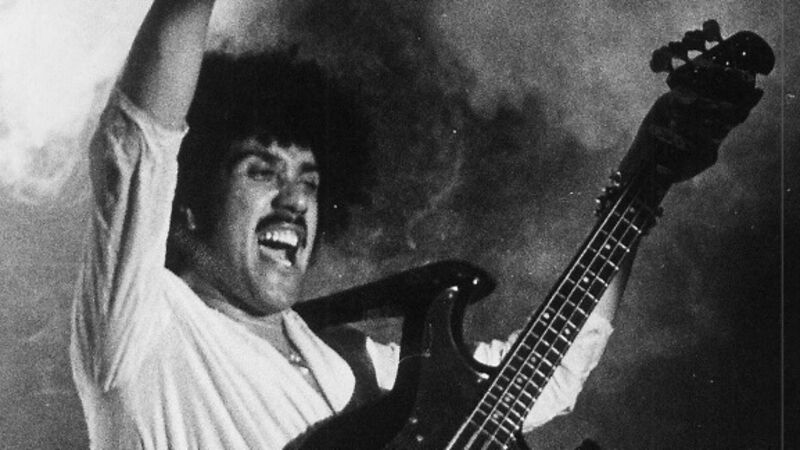Phil Lynnot's biography highlights how proud the rocker was to be Irish

PHIL LYNOTT was the original Irish rock star. Wiry, exotic, and always fabulously turned out, in late 1960s Dublin he looked like a visitor from another planet. Yet he was fiercely proud of his Dublin identity, with a knowledge and appreciation of Irish culture and heritage that put peers to shame.
Such were the contradictions that drew rock biographer Graeme Thomson to Lynott. In his new biography of the Thin Lizzy singer — written with the approval and co-operation of the musician’s estate — Thomson chronicles Lynott’s ascent from working class Crumlin to the top tier of global rock, and explores the degree to which his background as the son of a Irish mother and British Guyanan father moulded his identity.
“He was almost a superstar from the age of ten,” says Thomson, also the author of biographies of Kate Bush and George Harrison. “People just stopped and stared. There was an element of him using that to his advantage. ‘Everyone’s looking at me — people think I’m different. I’m going to use that to get ahead’. He was very driven and ambitious.”
On the other hand, Lynott’s relatively unorthodox heritage led him to embrace Irishness to a degree uncommon through the ’60s and ’70s, when cultural self-loathing was widespread, especially in Dublin.
“In many ways he was more Irish than anyone else. He accentuated that — it was to do with his family background, where he came from. As soon as he opened his mouth, you know you couldn’t get any more Irish. So there was that contradiction: He was different and used it. At the same time, there was always this desire to fit in and be accepted.”

Thomson was a passing admirer of Lynott and Thin Lizzy, who blazed a trail through the ’70s with anthems such as ‘Jailbreak’ and ‘The Boys Are Back In Town’. However, he was struck by the gulf between Lynott’s cocksure persona and his often sensitive songwriting. Here was more than merely another crotch-thrusting post-glam rocker, Thomson suspected.
“I was always aware of his music. More than that, I was intrigued by the man — the dichotomy in his life in terms of his music and his upbringing and the whole cultural context. There was something in his writing that nagged at me. You had a real poetic sensibility, which seemed at odds with how he presented himself. That was the starting point. He seemed an interesting guy with which to spend time.”
Even non-Thin Lizzy fans will find much to fascinate in Cowboy Song. Thomson’s account of the rock movement from which Thin Lizzy emerged is absorbing. While that period in Irish history is often portrayed as a claustrophobic cultural wasteland, by Thomson’s telling, Dublin and Cork brimmed with interesting characters and ambitious artists.

“Philip was deeply embedded in the cultural scene, with the poets and the folkies and the artists — the entire bohemian milieu around that time. He was quite into that and you can hear it in his writing.
“It’s amazing to consider how many incarnations of a musician he could have been. There was so many options. At end I think Thin Lizzy became quite a narrow avenue for his creativity. He was a gifted man, a keen reader and writer.”
Not that the picture Thomson paints of Ireland at that time is overly romantic. Religiosity was still a dead hand pressing down; growing up in Crumlin, Lynott, like many of his friends, would have dreamed of escaping his grim, grey world into which he’d been born.
“While there was a very rich and vibrant scene, parallel to that it was, I gather, a very repressive time. You could see people starting to confront that. I don’t think Philip was ever overtly revolutionary. He wasn’t politically minded particularly. But everything he was doing was a challenge to the status quo of the day — from the way he looked to how he hung out with, to the manner in which he carried himself.”

By breaking out of Ireland and achieving success on their own terms, Thin Lizzy would prove profoundly influential, says Thomson. “You fast-forward a few years and the country is starting to change. All these bands were coming up. There was a shift in consciousness. People were looking at Thin Lizzy going, ‘if they can do this… actually there is a way out of here.”
In Ireland Lynott and Thin Lizzy have long been revered, with the musician’s statue off Grafton St a place of pilgrimage. Internationally, the band’s profile has dipped and weaved, though lately Lizzy have started to receive the global recognition many in the hard rock community will feel is their due.
“In Ireland, he’s a folk hero,” says Thomson. “When they put up a statue, it confirms you are an icon. In America he is increasingly respected also. Figures such as Henry Rollins, Metallica, Dave Grohl of Foo Fighters... they all idolise him.”
Lynott’s story ends in tragedy, with the singer dying, aged 36, as a consequence of long-term drug use in 1986. Ultimately, he may have invested too much in rock stardom, says Thomson. When fame dwindled, as fame always does, it left a void mundane life could not fill. “He embraced [stardom],” says Thomson.

“Whether that was entirely healthy I don’t know. It became his rationale for existing really. When that inevitably started to decline — and most bands go through peaks and troughs — I don’t think he had anything else. He had two kids and a wife. But I’m not sure he had the foundations to replace his fame with something else. It may have been a factor in the way it all ended.”
Still, the reader does not come away from Cowboy Song grieving for Lynott. They step back blinded by the sheer force of his celebrity. He was, according to Thomson’s account, a natural born star. Rock and roll was merely the means by which he shared his luminescence with the world.
“I just picture him walking down Grafton St in ’68,” says the writer. “This big tall black guy, dressed to the nines. It must have been an extraordinary sight. He loved the attention — he was a star. Even before he picked up a guitar or sang a song.”








